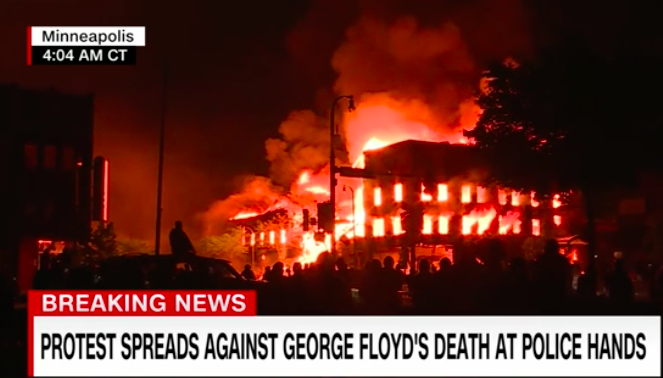Over the past week, I’ve watched and replayed that nightmarish video of George Floyd’s murder. The feeling of dread is different than previous killings by police—I can remember footage of the street where Michael Brown was killed, his body lying there on the pavement, his family and neighbors behind police tape watching in disbelief. That was the collective shock of a community after the murder of a child.
Watching life drain from a man as he’s pinned to the ground, calling for help and suffocating, burns really deep. That moment is immortalized and I know I’m not the only one who watched Floyd die over and over, enraged that this was allowed to happen.
In the four days after police killed George Floyd, demonstrations have left the Twin Cities of Minnesota—Minneapolis and Saint Paul—in disarray, and the magnitude of protest appears to have escalated over the course of the week. On May 26, I saw videos of people throwing rocks and bottles at police cars and tear gas canisters launched into an incandescent crowd. Last night, the Minneapolis 3rd Precinct was overrun by protestors, and like much of the city, was set ablaze. While the precinct was evacuated at 10 p.m. the fire was started around 11:30 and burned for hours, fed by protestors’ signs and debris.
I have never seen anything like this before in my life, and it’s clear the journalists and reporters haven’t either. But unlike them, I’m not shocked or confused by the havoc. I’m reminded of another time a city was facing police brutality, another time a building was overrun and burned, an act that I didn’t witness but has resonated with me.
Just 35 years ago, in 1985, a similar but polar-opposite incident occurred when Philadelphia Police Department evacuated Osage Avenue for a raid. Their target was MOVE, a black ecopolitical organization that had been terrorized by police for years and labeled as terrorists by police. On May 13, 1985, officers besieged the MOVE compound, using tear gas and over 10,000 rounds of ammunition before a police helicopter dropped a bomb was dropped on the roof of the building.
Eleven MOVE members—six adults and five children—were killed in the resulting fire. While firefighters attempted to keep the blaze, that also destroyed 61 other homes, contained to the MOVE compound, then-Philadelphia Mayor Wilson Goode (the city’s first black mayor had been elected a year earlier) and city officials opted to “let the fire burn.” The only adult survivor, Ramona Africa, was arrested and charged. No officers were punished for this tragedy, or for any acts of abuse against MOVE.
I can’t help but see parallels between the two situations, and the extreme differences that are circumstantial of the times. In 1985, not long after the civil rights movement, both white and black people were less accepting of new revolutionary ideologies, and the former oppressive police force of Philadelphia was able to proclaim MOVE as a municipal issue that needed to be “fixed.” Plus, the easy spread of information we have today wasn’t as common back then.
Which is why the wrongful incarceration and murders of dozens of African-American MOVE supporters were swept under the rug and forgotten without so much as a protest.
In 2020, the death of one man started a fire that the police had to let burn. Not because they wanted to, but because they had no choice. Now they know how it feels to be targeted, forced to retreat, and regroup. As for the destruction of property and vandalism that Minneapolis, Saint Paul, and other cities across the nation will have to deal with, I ask people not to judge the actions but understand the reactions. Imagine growing up your whole life and watching people who look like you murdered and incarcerated on a disproportionate scale, during which you learn that these same people have been oppressed, abused, and tortured for almost half a millennium—the only difference now is that you can see it with the press of a finger.
Is it not accurate to say we were overdue for this kind of demonstration? Should it be uninspiring to see people storm a police precinct that stands as a monolithic symbol of oppression and try to burn it to the ground? The fires of Minneapolis stores and businesses may be put out, but the inferno that was sparked by the murder of George Floyd isn’t going away any time soon. That powder keg has been getting filled for the past 400 years, and all those sparks over the course of this new century—all the black boys, girls, men, and women we’ve seen die at the hands of this oppressive system—has finally started to spread.




